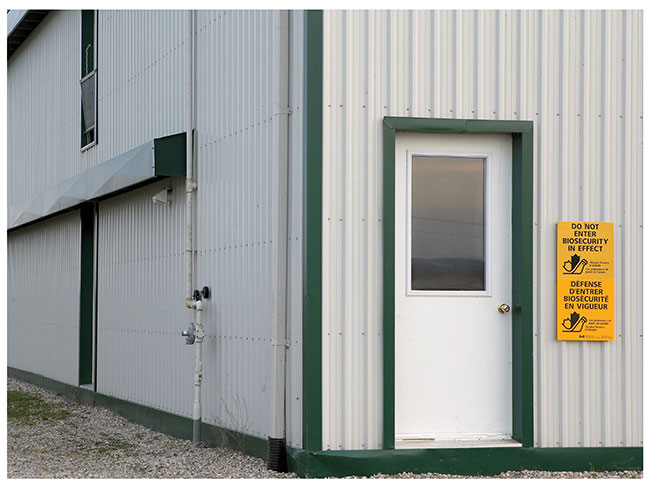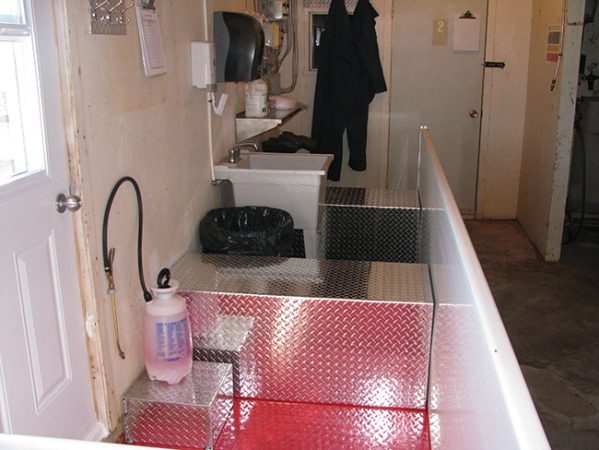
Building for poultry barn biosecurity
By Treena Hein
Features Barn Management Migration Matters BiosecurityBarn design is a critical factor for ensuring biosecurity measures are properly carried out. That said, here's a closer look at aspects that support maximum biosecurity.
 Experts say it’s critical that poultry barn entrances be designed with biosecurity in mind. PHOTO CREDIT: Chicken Farmers of Canada
Experts say it’s critical that poultry barn entrances be designed with biosecurity in mind. PHOTO CREDIT: Chicken Farmers of Canada The barn, especially the barn entrance area – is a critical factor for ensuring biosecurity measures are properly carried out in poultry barns. Everyone in the industry wants to make sure biosecurity is the best it can be, but how do we get there?
Chicken Farmers of Canada (CFC) guidelines outline the area needed in barn entrances to ensure enough room for mandatory footwear change and putting on premises coveralls. In addition, “a demarcation is required in the change area,” adds Steve Leech, CFC director of food safety and animal health, “and a barrier is highly recommended to fully enclose the restricted area.” Egg Farmers of Canada (EFC) guidelines similarly only require demarcation in the change area.
However, among those that believe strongly that physical barriers in the entry should be mandatory is Dr. Jean-Pierre Vaillancourt, a professor at University of Montreal and a member of CRIPA (Swine and Poultry Infectious Diseases Research Centre.
Neither ECF nor CFC tracks the number of chicken barns in Canada that have barriers versus demarcations, although CFC confirms that some chicken barns in Canada have barriers in place.
Is it time that all barns should have them?
Optimizing the barn entrance
As noted in the compliance story in this issue of Canadian Poultry, demarcation in the entrance area does not ensure that boot changing, handwashing and donning premises coveralls are done every time a person enters the barn – especially in light of the fact that the virus for highly-pathogenic avian influenza is present in wild bird droppings that could be on the ground outside the barn or anywhere else workers or visitors have walked before they enter the barn.
Demarcations on the floor also do not do a good job preventing those in premises boots and coveralls from easily going outside for whatever reason, and then back in the barn.
“I do clinics in Canada and around the world, and they know I am there to present about biosecurity and they ignore the clean/dirty zones right in front of me,” says Vaillancourt. “I was on a poultry farm in Quebec in late April 2022 for example, and there were migratory birds on top of the barn that I was taking pictures of. The farmer was in the barn and forgot something in his truck and came out wearing barn coveralls and boots into the yard where wild bird droppings were certainly on the ground. And I guarantee it’s the same in the rest of the country.”
To solve this problem, “a small hallway with two benches (physical barriers), making three zones, would be the best,” says Dr. Manon Racicot, a senior veterinary epidemiologist at Canadian Food Inspection Agency and adjunct professor at the University of Montreal, who has done many biosecurity studies with Vaillancourt.
“In the first area, the ‘dirty zone’ where you enter and leave the building, you remove your footwear and jacket,” she explains. “A closet or closed wardrobe to put coats and shoes in is a good idea. You then sit on the bench and swing your feet over to the second zone. Here in the handwash zone, you wash your hands using a sink or alcohol-based sanitizer. You then sit on the second bench and swing your legs over to the third restricted zone, where you put on farm boots and coveralls.”
This three-zone hallway area should have enough room for one person at a time to do all this, but not be any larger. “Unused space in the entrance tends to become a storage area for equipment and supplies,” says Racicot.
The benches should ideally be removable to facilitate cleaning and disinfection of the entrance at the end of each flock (or oftener) but must extend to the floor to avoid the circulation of litter and dust between areas. If there isn’t enough space for this hallway in the barn, the front door might need to be moved or a building extension constructed.
In terms of whether the industry needs mandatory phase-in of entry areas with barriers like benches, Leech says CFC really wants to emphasize that each producer should do their own evaluation.
“They should examine their barn entrances and compliance rate with protocols and make any necessary changes to ensure biosecurity is respected,” he says. “But they also need to look at how pathogens can enter through water, pests and possibly air inlets.”
Other important entry aspects
In terms of other aspects of biosecurity in barns, Racicot and Vaillancourt advise that entry doors should have a spring that closes the door automatically. This ensures entry of flies and so on is minimized.
It also prevents workers from leaving the door open to bring down the temperature in the entrance area during the summer heat. That is, farmers need to buy a fan or install air conditioning to ensure the entrance area is cool, especially for premises with breeders where workers spend the entire day within the barn, says Racicot. Access to a washroom is also an issue for these workers.
The entrance door should also automatically lock, which prevents a visitor from entering the building without respecting the biosecurity measures. A lock system with numbers is probably an easier system to manage than keys.
To get in, visitors could call for the code and be supervised by the farmer or farm worker already in the restricted zone to follow the proper boot, handwashing and coverall steps, or follow the farmer or farm worker who is doing the steps ahead of them as they enter the barn together.
Carcass handling
From a biosecurity standpoint, experts advise against taking out bird carcasses through the front door used by employees and visitors.
“A covered chute that puts dead birds into an outdoor container is an ideal solution,” says Vaillancourt. “When there is no alternative but the door of employees and visitors, put a container in the clean area of the barn that remains in the building at all times and another container in the dirty area to avoid leaving dead birds on the floor and crossing the hygiene barrier/delimitation without applying the right precautions (e.g., changing boots).”
He adds that final disposal of the carcasses should be in a closed container with no access to wild birds and other animals. Leaving carcasses outside nearby each barn until the end of the day is attractive to wildlife and is posing a risk of introducing a disease.

For maximum biosecurity at the barn entrance, experts recommend having three zones separated by barriers, including a ‘dirty zone’, a handwashing zone and a zone to put on boots and coveralls.
Location and materials for barns
In the view of these scientists, there should also be strict norms for new poultry barn builds in Canada, including minimum distances from other poultry facilities. “They do this in Australia and in Italy,” Vaillancourt says. “In Italy, they have a series of risk factors that they look at, including distance from other farms, before they allow construction to occur.”
Research by Vaillancourt, Racicot and their colleagues has found that recommended distances from one poultry barn to another can vary from 0.5 km to 20 km, depending on factors like which pathogens are considered and prevailing winds.
CFC says that currently in Canada, chicken barn locations are provincially legislated and that these regulations can vary from municipality to municipality.
On July 22, a fourth farm in Quebec had an HPAI outbreak, in a turkey flock in Saint-Gabriel-de-Valcartier. On July 25, Vaillancourt said he was quite sure it was a turkey farm (at least two of the other eight Quebec cases have been on turkey farms) and reports that there is another commercial poultry operation very, very close to this farm. Vaillancourt is surprised HPAI outbreaks are continuing in Canada and believes that this shows the environment is very contaminated with HPAI.
Other considerations
In terms of barn construction materials, poultry farmers are already aware that materials should be durable, easy to clean (scrape and sweep) and easy to disinfect through pressure washing and application of disinfectant. (See the November 2021 edition of Canadian Poultry for a story on the benefits of Insulated Concrete Form construction for biosecurity and more).
However, farmers may not typically include a fumigation room in the barn design. “Objects or equipment that cannot be washed with water can be disinfected through hand wiping, but fumigation is recommended,” says Vaillancourt. “It’s more thorough and a better standard procedure because leaving disinfection done by hand means it doesn’t already get done.”
A fumigation room should be located near the entrance. This room must be airtight and have two accesses, one from the outside to place equipment into it, and another access inside to recover the disinfected items.
No one in Canada or beyond wants disease to enter poultry barns and everyone wants compliance with required barn biosecurity measures to be as high as possible. Time will tell if the three-phase entry or other aspects described in this and the other article in this issue will become mandatory over time to achieve this.
Print this page